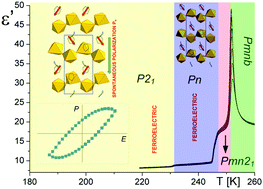Exploring a hybrid ferroelectric with a 1-D perovskite-like structure: bis(pyrrolidinium) pentachloroantimonate(iii)†
Abstract
Herein, a multi-phase ferroelectric and ferroelastic pyrrolidinium-based organic–inorganic hybrid (C4H8NH2)2[SbCl5] is presented. Its crystal structure consists of [SbCl5]∞2− chains that interact with pyrrolidinium cations through an expanded system of hydrogen bonds. A decrease in temperature gradually diminished the freedom of motion of the cations, which led to three reversible structural phase transitions. A paraelectric–ferroelectric anomaly (Phase I → Phase II) appeared at 252 K, and its ferroelectric properties were maintained over all the low-temperature phases (II, III and IV). The variable temperature single-crystal X-ray diffraction, dielectric spectroscopy and proton magnetic resonance (1H NMR) results provide information about the general mechanisms of the phase transitions, which are assigned to the progressive ordering of the pyrrolidinium cations and deformations of the inorganic chains. The ferroelectricity was evidenced via P(E) and pyroelectric measurements. Finally, the symmetry decrease associated with structural anomalies was evidenced by the presence of a ferroelastic domain structure.



 Please wait while we load your content...
Please wait while we load your content...